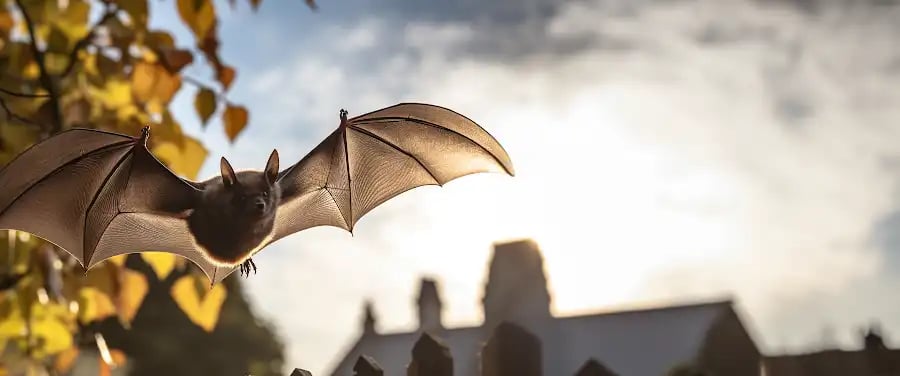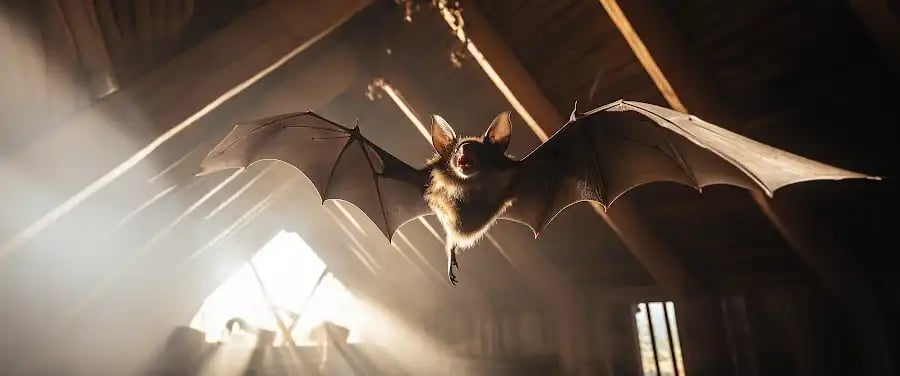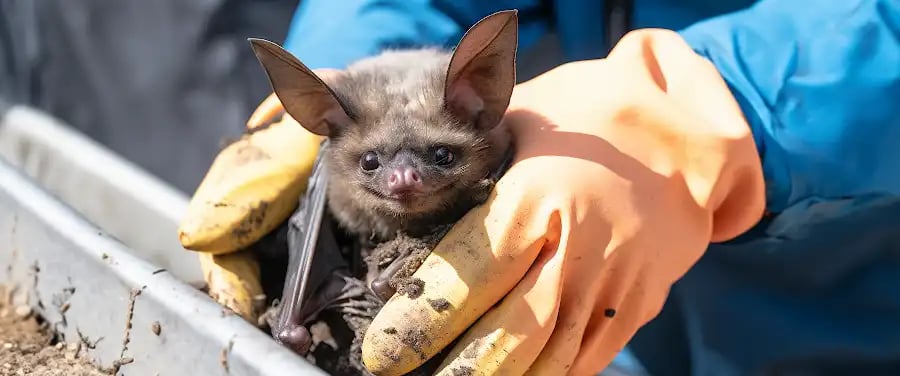
Ever had that moment when you turn on your porch lights and see a flurry of shapes darting around, only to realize, much to your surprise and slight horror, that your home has been invaded by bats? While some might love the idea of sharing their space with these winged creatures, many of us would prefer otherwise. But did you know there are legal implications to removing bats from your premises? Yup, you can’t just pitch them out willy-nilly.
Firstly, it pays to understand that these small yet vital animals play a critical role in maintaining our ecological balance. They’re incredible at controlling pests, as a single bat can eat thousands of insects in a single night! Plus, they are crucial seed dispersers and pollinators in many ecosystems. Sound exciting already? Well, hang tight because this is simply the tip of the bat-berg.
In this article, we’re going to dive into the depths of what you need to know about the laws and regulations associated with bat removal. We’ll explore the legal side of things, help you understand when and why bat removal is necessary, and even introduce you to some bat-friendly removal techniques. Before you think about shooing these critters away, it’s essential to know what you’re up against. After all, knowledge is power — the kind that keeps you legally safe while ensuring the wellbeing of our bat friends. So, without further ado, let’s take flight into the fascinating world of bat removal. And speaking of that, why is bat removal necessary, you may ask? Well, let’s find out.
Is Bat Removal Legal?

Bat removal, a common yet convoluted concern, demands a clear understanding of international laws and regulations. Bat protection laws and conservation methods come into play as they present the dichotomy between lawful and unlawful practices of bat removal. Let’s delve further into what characterizes these practices and under what conditions bat removal becomes justifiable.
Internationally, bat removal, often classified under pest control, is bound by various regulations owing to the pivotal role bats play in biodiversity and maintaining ecological balance. The notion that complete bat removal could be detrimental to our environment underscores laws primarily inclined towards bat conservation.
Lawful vs Unlawful Bat Removal
Several countries have set lawful methods to remove bats, focusing on the gentle handling of these creatures without causing them physical harm. These may include using devices that usher bats out of premises without hurting them or seeking professional help who use ethical, non-lethal means for the same. Encouraging practices like these, lawful bat removal methods aim at reducing the negative human-bat interactions while still preserving the species.
On the other hand, practices like exterminating bats using poison or causing them fatal injuries, are considered unlawful bat removal techniques which are sternly discouraged by global environmental conservation bodies due to their potential upset to the ecosystems.
Conditions Justifying Bat Removal
While bats play a significant role in biodiversity, their removal becomes justifiable under specific circumstances. For instance, if a colony of bats pose a direct threat to human safety, or start inhibiting human living spaces thereby leading to potential health risks, bat removal may be considered necessary.
| Condition | Justifies Bat Removal | Unlawful or Lawful |
|---|---|---|
| Threat to Safety | Yes | Lawful |
| Health Risk | Yes | Lawful |
| Property Damage | Yes | Lawful |
| Nuisance | No | Unlawful |
However, it’s important to note that any action undertaken should comply with the prescribed guidelines and protocols for humane handling of bats since they are protected by laws due to their ecological importance. For a comprehensive understanding of the laws and guidelines on bat removal.
Bat removal, when done within the confines of regulations, contributes positively towards bat conservation while also mitigating any potential human-bat conflict. Therefore, understanding the nuances of bat protection laws and differentiating between lawful and unlawful bat removal practices are crucial. The aim is to ensure a harmonious coexistence of humans and bats. After exploring the international perspective on bat removal, let’s switch our focus to the Federal Laws on bat removal in the U.S.
What are the Federal Laws on Bat Removal in the U.S.?

When it comes to bat removal in the United States, there are several federal statutes in place that demand our attention. These laws have been established not just for bat safety, but also to maintain the ecological balance since bats play a significant role in controlling the population of pests.
Firstly, we have the Endangered Species Act (ESA). This law was put in place to prevent the extinction of species and conserve the ecosystem they rely on. It stipulates that if a bat species is listed as threatened or endangered, it becomes illegal to harm, harass, kill, or remove them without a permit. Violations could lead to significant criminal and civil penalties, indicating the seriousness with which these laws should be taken.
Another key player is the U.S. Fish and Wildlife Service (USFWS), a federal agency that keeps a watchful eye on wildlife conservation, ensuring compliance with various acts, including the ESA. They have the authority to grant permits for bat removal in specific situations where harm to humans is imminent, which would otherwise be illegal. It’s noteworthy that even with a permit, measures must be taken to ensure the minimum harm to bats and their habitats.
Lastly, the Migratory Bird Treaty Act (MBTA) may seem to be exclusively about birds, but some of its provisions have been extended to protect bats. This act makes it illegal for anyone to take, possess, import, export, transport, sell, purchase any migratory bird, or any part, nest, or egg, unless allowed by a valid permit. The interpretation of ‘take’ here is broad and includes actions that result in the disturbance or displacement of migratory birds, or in this context, bats.
To navigate through these regulations, a comprehensive guide by the USFWS is a valuable resource, and it details techniques for bat removal and conservation in accordance with the law.
Understanding these laws is crucial before undertaking any bat removal activity. Ignorance of them is not only detrimental to our furry friends; it can also lead to serious legal repercussions. So, tread carefully.
The laws at the federal level, however, are not the be-all and end-all of it. Depending on where you are in the U.S., there could be additional state laws that govern bat removal. Stay with us as we delve into this in our next section “ Are There any State Laws on Bat Removal?”.
Are There Any State Laws on Bat Removal?

The laws and regulations on bat removal can differ drastically from state to state, and the enforcement severity can range from lax to severe depending on where you are located. For the protection of both the bats and the people involved, it’s imperative to understand and follow these local laws when considering bat removal.
Some states classify all bat species as protected. Others maintain specific lists of protected species, while there are states with no explicit laws covering bats. It’s critical to understand what applies to the specific state you are in. A list of individual state statutes can be found at the National Conference of State Legislatures website.
The violations for not adhering to these laws can vary in severity. In some states, you might receive a warning for a first offense, while others might issue hefty fines or even jail time for more significant violations. Even within the same state, enforcement can vary based on local ordinances and the specific species involved.
If you want to learn about the specific laws and regulations on bat removal in your area, there are a few courses of action you can take. You might consider contacting your local animal control or wildlife service for information. Additionally, online resources like the aforementioned National Conference of State Legislatures can provide state-by-state details.
When researching the local laws, be sure to look for information not just on the legality of bat removal itself, but also on the approved methods of removal. Different states and localities may have regulations that prohibit certain methods considered harmful or overly stressful to the bats.
It’s important to remember that bats play an invaluable role in our ecosystem – they help control pests and contribute to pollination and seed dispersal. Therefore, even if your state doesn’t explicitly protect bats, removing them should be a last resort and should be done in the most humane manner possible.
As we move forward to consider the laws and regulations on bat removal, we’ll delve into the role of wildlife rehabilitation centers in bat removal up next. These centers play a dialed back but still essential position in ensuring the laws are followed and the bats are managed in the most caring and proven-effective ways.
The Role of Wildlife Rehabilitation Centers in Bat Removal

The significance of wildlife rehabilitation centers in bat population management cannot be overstated. These creatures of the night are a crucial part of our ecosystem, but can present a problem when their colonies cohabitate in human dwellings. This is a common occurrence given that many bat species are protected by law and cannot be harmed or removed without proper protocol. To navigate this situation legally and ethically, the assistance of wildlife rehabilitation centers is crucial.
Wildlife Rehabilitation Centers and Bat Conservation
Wildlife rehabilitation centers play a pivotal role in bat conservation. Certified by state and federal agencies, they provide refuge to bats dislocated due to human activities or natural disturbances. They operate following laws and regulations, ensuring that the bats are cared for while minimizing human-bat conflicts.
The strength of our ecosystem relies partly on bats, responsible for pollinating plants, eating harmful insects, and dispersing seeds. According to Bat Conservation International, bats save the US agriculture industry over $3 billion annually by controlling pests. This figure underlines the importance of their conservation and the role these centers play.
Bat Transfer Protocol and Humane Removal
Bat transfer protocol is critical to ensuring the successful relocation of bats. When you encounter bats on your property, the most important thing to remember is never to handle them with bare hands due to the risk of disease transmission.
A humane and legal method of bat removal involves the use of exclusion devices that allow bats to naturally leave and prohibit their re-entry. This method, coupled with house sealing and property maintenance, is recommended by the Humane Society of the United States and exemplifies humane bat removal.
| Method | Description | Legal Considerations |
|---|---|---|
| Exclusion Devices | Non-lethal devices that allow bats to leave and provide a one-way exit | Legal and endorsed by many wildlife organizations. |
| House Sealing | Prevents bats from re-entering buildings. | Preventive measure, legal as long as done outside of the breeding season. |
| Repellants | Substances designed to deter bats. | Legal, but largely ineffective as per wildlife experts. |
| Trapping | Capturing bats for relocation. | Requires special permit and training for legality, generally discouraged due to negative effects on bat populations. |
Should you find a lone bat, or an entire colony in your residence, you are strongly advised to contact a local wildlife rehabilitation center or a professional bat removal company to ensure that you adhere to the laws and regulations on bat removal. More information on this can be found on the official website of the U.S. Fish & Wildlife Service here.
Maintaining harmony with our bat population is a unique and necessary challenge. As we transition to our next topic, one thing remains essential: your actions should be underpinned by understanding, respect, and legal requirements concerning these beneficial creatures. How to Properly and Legally Remove Bats? Let’s delve deeper into that topic.
How to Properly and Legally Remove Bats?

Before embarking on any bat removal endeavor, understanding the laws and regulations involved should be your primary concern. Bat removal preparations and procedures are governed by specific laws, highlighting the critical need for precautions in their handling, and identifying when it’s time to involve professional help.
Let’s dive into these aspects of bat removal for a clearer understanding.
Preparations for safe and lawful bat removal
First things first, you’ll need to identify the bat species in your residence or business. Some species are protected under Federal law such as the Endangered Species Act, where their killing or harassment is considered illegal. It is, therefore, essential to be careful when dealing with these creatures. It’s crucial to remember that bats are beneficial to the ecosystem!
So, your initial steps should include:
- Identifying the bat species with the help of a bat field guide or consultation from a local wildlife agency.
- Determining if the bats are protected under local, state, or national laws from resources like U.S Fish and Wildlife Service.
- Gathering information about the appropriate time to remove bats. Bats usually have pups in the summer months. In many places, it is illegal to disrupt bats during pup-rearing season, as the pups cannot fly and will die without their mothers.
The Correct Bat Removal Procedures and Precautions
In many jurisdictions, performing a bat removal without professional help is deemed illegal. Therefore, having a firm understanding of the bat removal procedures and precautions is crucial. Let me break it down for you:
| Procedure | Precaution |
|---|---|
| Raising a simple bat exclusion device | Ensure that all other exit points are sealed off so as not to trap bats inside |
| Use of a one-way exit system | Only use it outside the bat maternity season to avoid trapping flightless pups |
| Do not use repellants, including ultrasonic devices or chemicals | They do not have proven effectiveness, and some may be harmful to bats |
Identifying When to Involve Professionals
Attempt removal only if you’re 100% sure it’s safe and legal to do so. Most of the time, professional help is highly recommended, not just for legal reasons, but for human safety as well. Bat droppings (guano) can contain harmful pathogens like the Histoplasmosis fungus.
Moreover, professionals know all about bat exclusion systems and how to ensure bats are completely gone. They also know how to clean and sanitize the area afterward. Statistics show that professionals have a 90% success rate on the first try compared to a DIYer’s 33%!
In the end, remember that it’s all about coexisting with these little mammals in our ecosystem safely and responsibly. After ensuring the proper, lawful removal of bats, we must also focus on… How can One Prevent Bats from Returning? Tune in to the next section to find out more.
How Can One Prevent Bats from Returning?

Few animals invoke as much dread as bats. However, we often forget they play an essential role in our ecosystem and, as such, are protected by multiple laws and regulations. If you’re dealing with a bat problem in your building, it’s essential to know how to handle it responsibly and legally. The best solution involves bat re-entry prevention and bat proofing techniques aided by periodic inspections.
According to Bat Conservation International, implementing reliable bat-proofing techniques is the most effective way to ensure bats don’t return. Focusing on this strategy will not only keep the bats away but also maintain your building’s integrity and promote health and safety.
Bat Re-entry Prevention
Remember, it’s often illegal to obstruct entry points for bats during their maternity season, typically from early spring to late summer. Let’s look at some techniques to keep bats from coming back:
- Seal all potential entry points except the main one used by bats. This process is known as exclusion.
- Install one-way exclusion devices that allow bats to leave but prevent their return. This technique is best applied in the non-maternity season.
- Keep the surrounding area free from clutter that can turn into potential roosting sites.
Bat Proofing Techniques
Proper bat proofing involves meticulously inspecting your building and sealing all possible entry points. These can be vents, chimneys, roof edges, and others. A few proven methods include:
- Caulking and sealing gaps and cracks
- Installing metal caps over chimneys
- Using mesh screens over vents
Such steps, when taken with meticulous precision, can yield beneficial results.
The Importance of Periodic Inspections
Routine inspections form a significant part of successful bat control. Specialists would look for signs such as guano (bat droppings), rub-marks around potential entry points, and monitor for bat activity during dusk and dawn when bats are most active.
Working with a professional pest control firm ensures a thorough job and eliminates the chances of harming bats. And remember – bats are considered an endangered species in many parts of the world, respect their habitats while ensuring your living space doesn’t intersect with theirs.
As we move into discussing the penalties for illegal bat removal, remember the key is not to break the law but to work with it. Bats are unique creatures, and our attempt should be to co-exist rather than remove them altogether.
Conclusion
In conclusion, effective and responsible bat management is not just a matter of maintaining a safe and comfortable environment for us humans. It’s also about respecting the lives and habitats of these often misunderstood creatures. As we’ve delved into the laws and regulations on bat removal, it’s clear that a lot of effort has been made to ensure the protection and conservation of bats, especially considering these creatures’ significant role in ecosystems by controlling insect populations.
You may see them as mere pests, but these nocturnal animals, with their limited visibility and flight skills, are remarkable creatures protected by law. Ignoring these laws can lead to severe legal implications, underscoring the urgency to educate ourselves and maintain responsible practices in dealing with bats. Think about it: would we want our homes intruded upon and taken without consideration? The same holds true for these creatures.
Bearing this in mind, it’s always best to consult with professionals and authorities for proper bat-related laws when faced with bat issues. Remember, if there’s one thing that reverberates as loudly as a bat’s call in the night, it’s this: every life matters and deserves respect, including those tiny squeaky ones hanging upside-down in your attic.
Now that you’re armed with this knowledge, the next step is to apply it. Consider taking action by reaching out to local wildlife removal agencies to understand your bat problem better. Be kind to bats, and keep things legal – it’s better for them, you, and our collective future!
Next time you encounter these winged friends in unexpected places, remember this dialogue about laws and regulations on bat removal. Let’s strive to make our lives and theirs coexist in harmony and accordance with the law, because in the grand scheme of our ecosystem, every creature plays its part, even the bats.
Frequently Asked Questions about Laws and Regulations on Bat Removal
Table of Contents
- Is Bat Removal Legal?
- What are the Federal Laws on Bat Removal in the U.S.?
- Are There Any State Laws on Bat Removal?
- The Role of Wildlife Rehabilitation Centers in Bat Removal
- How to Properly and Legally Remove Bats?
- How Can One Prevent Bats from Returning?
- Conclusion
- Frequently Asked Questions about Laws and Regulations on Bat Removal



